Mercury's greatest hits
A look back at some of the former FoMoCo division’s best cars
06/11/2020


Mercury's final years were spent peddling cars, minivans, and SUVs discernible from Fords only by model names, cosmetic tweaks, and higher price tags. But from the marques' inception in 1938 through the majority of the 20th century, Mercury was the junior Lincoln: A rolling example of how a Ford could look and perform given added measures of style and luxury.
By the end of the 1930s, Ford was being outflanked by General Motors' multiple divisions, which each targeted a distinct audience. As Henry Ford clung to the notion that his cars should be prized for their frugality and sturdiness, Oldsmobile and Buick were appealing to a new generation of entry-level luxury car buyers.
It was left to Henry's only son, Edsel, to salvage the company. Edsel rose to the challenge, pulling off a seemingly impossible, paradigm-shifting realignment of Ford's vast product image during his short lifetime.
True, the 1939 series 99A Mercury 8 automobiles were powered by a larger Ford flathead V-8 and had a solid front axle. But the Sedan-Coupe also had a mouthwatering hardtop roofline, with no clunky B-pillar to interrupt its flow. That first hardtop treatment was only the start. In the years bracketing World War II, Mercurys differed from Fords not only by their elaborately delicate grilles and ample stainless side moldings, but also by their chassis. The wide-body Mercury models from 1941 through 1948 rode on 116-inch wheelbases, 2 inches longer than the corresponding Fords. A big deal? Probably not, but it still created Mercury exclusivity.
The difference in wheelbase increased in 1949 to 4 inches, which was the least of Mercury's news that year. The '49 Mercury was an acclaimed, almost magical car. As a result, the 1949 and 1950 versions— regardless of body style—have been prime collector cars for a generation, at least. The 1951, a nearly identical spinoff despite its extended rear fenders and distinctive vertical taillamps, has long been more moderately priced as well as a favorite with customizers. All of these cars pushed the definition of what was attainable, fast and stylish, sometimes unmercifully so, in the Turnpike Cruiser context. You might be taken a little aback by how many Mercury products were built in comparatively miniscule numbers, and at their startling affordability today. That, we should add, is with a healthy universe of easily found reproduction parts and some enthusiastic club support.
Let's move a couple of years ahead. Hotrodders have always bragged about using Mercury flatheads, so let's check out the last Mercurys to actually have them, the 1953 models. Want a presentable, driveable 1953 Monterey hardtop, sans the custom treatment, with a 255-cu.in. flathead V-8? Be flexible on condition, and you can easily find one for somewhere between $15,000 and $25,000.
Step another two years closer to the present, and we come to the 1955 and 1956 lineup at Mercury, the Montclair and the Monterey, with very big, rangy styling, upright taillamps and strong distinction. If perfection is a must, $40,000-$50,000 will buy it, with a steel roof. As you move from "show" to "driver," the price drops accordingly. Barely more than 50,000 Montclair hardtops were made in 1956 and their survival rates are a fraction that of mid-Fifties products from Chevrolet, which became highly collectible long before any Mercury did.
A full-size Mercury from either side of 1960, in fully functional condition and with nice cosmetics, has long been and still remains a rational buy. Big Mercs, even the likes of a 1964 Marauder fastback hardtop with chest-thumping FE horsepower, will run you $12,000 on average for presentable car, or north of $20,000 on the high side. If you want something unusual from this era, try a 1961 Meteor 600 (total build of 18,117) or Meteor 800 (35,005). The only really large 1960s-era models from Mercury that have consistently pulled in significant dollars are the performance S-55-optioned hardtops, also produced between 1962-'66.
In many cases, Mercury's smaller cars can be more fascinating than its larger ones. In less common instances, you can find one packing the same sort of big-block V-8, displacing 390- or 428-cu.in., as its bigger brethren. When it comes to a Comet, a Montego, or a Cougar, even a more plebian OHV Ford straight-six, or a small-displacement V-8, is totally worthy.
In the Comet's case, the larger issue is that Mercury was trying to generate a slightly smaller car with full-size styling, trim, and appointments when it debuted its new compact for 1960. Although they share the same Ford chassis, suspension, and driveline, the Comet projects a drastically different profile than a Ford Falcon. Comets, the pre-Maverick kind, are relatively inexpensive, with a 289-cu.in. V-8, four-speed Caliente convertible checking in at an average of $20,000 or so in most cases. A straight-six Comet sedan can usually be had for less than $5,000.
The Mercury Cyclone stepped up from being a hot compact to a midsize muscle car in 1966, still as a Comet, then made the leap to become a premium performance version of the renamed Montego midsize line in 1968. Cheap muscle all but vanished a long time ago, but a Montego-based Cyclone, even a NASCAR-inspired Spoiler variant with big-block motivation and a four-speed, can seem like a bargain compared to other cars of the era.
Mercury also periodically offered some interesting captive imports. These days, they're tough to find free of either rust or wreck wrinkling, but Mercury sold a substantial quantity of European-built Ford Capris through its dealer network during the 1970s. A decade later, Lincoln-Mercury dealers sold Ford-built German imports under the Merkur (German word for Mercury) brand.
There is, truly, a Mercury for all tastes, with broad selection in body design and era-themed styling _ air, nearly always for a little less money than other brands. It's hard to have a beef with that long-ago slogan, because, indeed, Mercury's got it.

1939 99A
The original Flash: Edsel Ford's vision and E.T. Gregorie's boundless creativity, mixed with a few Ford components, created the original Mercury in 1939, giving the _ rm an upward presence it enjoyed for decades to come. Some styling cues echoed the '39 Ford De Luxe line, but the remarkably sanitary hardtop roofline changed everything. A 239-cu.in. flathead V-8 rated at 95 hp provided the motivation. With just 8,254 of them produced, this Sedan-Coupe stands as a low-production classic of the immediate prewar years, and as a certifiable landmark of design at Ford.

1946 Convertible
Judicious use of chrome and unique trim bits transformed the seen-it-every-place-you-look, broad-shouldered cars from Ford into magical Mercurys from 1941 on. This convertible, produced in 1946, represents the tail end of those models, which were phased out in '48. Despite an older design, it was a boom year at Mercury, which managed 50,000-plus unit sales, including 7,586 convertibles. Each one of them was powered by the 239-cu.in., 100-hp flathead V-8 that was already in the foundation of Ford folklore. The hair-thin vertical grille elements are delicate and timeless. The convertible pictured is a rare right-hand drive model built for export.

1949 Sport Sedan
In the 21st century, we still sometimes have difficulty getting ahold of the sensation and thrill that enveloped the real postwar Mercury lineup when it crashed into America's consciousness for 1949. Calling it game-breaking is a reckless understate-vinyl, the reborn cars included this 1950 Sport Sedan, powered by a longer-stroke, 255-cubic-inch flathead. This unforgettable generation of Mercury existed from the 1949 through 1951 model years. They were able to push Mercury past its 1-millionth sale.

1954 Sun Valley
The 1954 Mercury Sun Valley gave "sunroof" a literal connotation. The smoked, see-through roof panel was pretty dramatic on its own, but Mercury also got a brand-new OHV V-8 engine to replace the aged flathead, displacing 256 cubic inches. Despite its obvious uniqueness, the Sun Valley actually outsold its model-name stablemate, the Monterey convertible, in 1954. Sun Valley hardtops were built to the tune of 9,761 units, easily outstripping soft-top sales that year by close to 2,500, a substantial margin.

1958 Turnpike Cruiser
Compared to its immediate predecessor, the 1958 Mercury Turnpike Cruiser was relatively conservative, its front parking lights conventionally relocated below its quad headlamps. For all its extravagant looks, this was an exceptionally potent car: 430-cu.in., 360 hp, moving more than 4,200 pounds. The visual cues to a Turnpike Cruiser are its dual air inlets above the windshield and its retractable rear window. About 3,500 were built.

1963½ Comet S-22
At Mercury, "compact" was not a throwaway synonym for "cheap." The 1963 Comet line, and in particular, this example of a Comet Special S-22 hardtop, stands as all the evidence anyone should need. This was the performance Comet, with strong visual appeal and 164 hp worth of legitimacy from its 260-cu.in. V-8, a precursor of the forthcoming Cougar. It sold decently, to the tune of 5,800 plus, as the notion of performance in every size began gaining serious momentum. A 1963 cue was the wraparound side trim that enhanced the Comet's character lines.

1964 Colony Park
When it came to station wagons in 1964, the Mercury Colony Park, with your choice of seating for either six or nine, was unsurpassed in comfort and appointments. The defining visual feature, as you might guess, was the imitation woodgrain trim on either side. As outfitted for nine, the more popular (5,624) of the Colony Park wagons approached 4,300 pounds. It rolled strongly with the urging of a four-barrel, 390-cu.in. V-8 that packed 266 hp and was restricted to Mercury wagons. A luggage rack cost $64.35 on the factory option list and led the available extras in popularity. These were very dressy, elegant wagons.

1964 Marauder
It's easy to see that Mercury took one nameplate very seriously in 1964. Marauder. That was a big player in performance on the NASCAR and USAC stock car circuits, offered with two versions of the wild 427-cu.in. muscle V-8, with up to 425 ripping horsepower. The Marauder was a subrange in the Montclair series for 1964, with a brawny, ballistic front-fender theme. It's key to note that two Marauder styles were produced that year: a fastback two-door hardtop, and also a fastback hardtop with four doors, a highly unusual body style.

1965 Comet
Mercury's Comet confidently maintained its big-looks, small-package formula when 1965 rolled around, copying big-car chic by adopting vertically stacked headlamps that year. It's a stretch to call the six-passenger 1965 Comet station wagon a roaring success, since just 4,814 of them were produced, but the car's visual and prestige impacts were both well beyond its sales from the standpoint of proportionality. The majority of these Comet wagons, sans the Villager's faux wood, received the simple, all-but-unbreakable OHV straight-six, displacing 200 cubic inches and delivering a reasonable 120 hp. Front seat belts were newly standard.

1967 Cougar XR-7
The U.S. auto industry produced some memorable cars with enduringly attractive design work in 1967, and the Mercury Cougar still stands proudly near the top of that list. It's easy, and misleading, to simply call it a rebodied Ford Mustang. The Cougar, and especially this Cougar XR-7, reframed the notion of a compact coupe, its highly stylized interior presenting an inviting environment. A four-barrel, 320-hp 390-cu.in. V-8 upheld its muscle credibility.

1968 Park Lane Convertible
In 1968, you could even get a vinyl roof on a Colony Park wagon. For those wanting still more, Mercury offered imitation wood side trim on the sedan, hardtop, and convertible models in the premium Park Lane series. Today, this eye-busting appearance goodie is commonly called the "yacht," package, though authentic examples of it are anything but commonplace. A 1968 Park Lane convertible is already a rare car, just 1,112 produced. As you can imagine, a wood-trimmed version with documentation is extremely scarce.

1968 Cyclone Fastback
Dramatic right off the showroom floor, the 1968 Mercury Cyclone gained enormous attention from its successes in NASCAR, driven by Cale Yarborough and LeeRoy Yarbrough; lesser so on the drag strip, where Al "Batman" Joniec campaigned one. It didn't necessarily mean big sales, though, as Cyclone fastback production totaled 12,260. A majority of today's survivors are fitted with the 390-cu.in. four-barrel V-8, rated at 335 hp. The Cyclone was just one element of Ford's restyled and redubbed midsize line that year. Want a super-rare Mercury? Go find one of the 1,368 non-fastback Cyclone hardtops that the division built in 1968.

1970 Cougar Eliminator
Mercury, and a lot of other car manufacturers, reached the apogee of the first great performance era in 1970. The Cougar Eliminator, a package designed by Larry Shinoda, entered its second, and last, year in 1970. Looks-wise, it groups a satin-finish hood scoop, blackout grille and rear wing, along with stripes. Power choices in 1970 ranged from the Boss 302 up to an R-code, Ram Air 428. A 351 Cleveland was offered in 1970 only. The luxury interior, combined with rock-hard muscle, only produced a moderate seller, with 1970 Eliminator production limited to 2,267. It remains, however, an instantly recognizable and desirable Mercury.

1972 Montego GT
The really big horsepower numbers were dead and gone—the best was a 429 worth only 201 hp—but in 1972, the Montego GT epitomized what remained of enthusiastic driving at Mercury. Still, the imitation "performance" hood and wind-shaped mirrors caught the eye, and the fastback body did most of the running and blocking for Ford in NASCAR that year, so people did notice the Montego GT. It sold just over 5,800 units, which is why restored Montego GTs from 1972 are seen so seldom at shows nearly five decades after they were initially produced.

1980 Bobcat Sport
All right, enough. Mercury's version of the Ford Pinto got a new sloped front end in 1980, the first (and only) restyling of the Bobcat's lifespan. The Bobcat wagon was available in both base and wood-sided Villager editions that year, with available Ford V-6 power. The one depicted has the Sport option group. More than 9,000 people decided to buy 1980 Bobcat wagons. So there.

2003-'04 Mercury Marauder
This model revived a famous name from Mercury's past and applied it to a lively sedan based on FoMoCo's Panther platform which underpinned the Ford Crown Victoria and Lincoln Town Car. The Marauder benefited from a stiffer frame, suspension upgrades, a sporty wheel/tire package, 3.55-geared limited-slip differential, and a DOHC 32-valve 4.6-liter V-8 making 302 hp and 318 lb-ft of torque. The Marauder was initially available in basic black, but would also be sold in Dark Blue Pearl and Silver Birch, with Dark Toreador Red replacing blue the following year. Ford was prepared to build 18,000 examples per year, but only managed to sell 11,052 in two years, making them a fun and unusual collectible today.
If you’re thinking about a new garage or shop for your classic cars, it may help to picture it in your mind, starting with the colors. But which colors should you choose?
If you appreciate the virtues of a great-colored car, then you can certainly understand that choosing the right colors for your building is nothing to take lightly. After all, you could be looking at those colors for decades.
In the following, we’ll share the most popular exterior colors based on recent customer data from Wick Buildings. But we’ll do a lot more than that. To help you on your color quest, we’ll discuss the latest exterior color trends with Brynn Wildenauer, Architectural Color Designer at Sherwin-Williams.
We’ll also share tips for choosing colors AND describe the exciting paint color developments at Wick Buildings, developments that give customers a truly exceptional palette of high-quality color coatings to choose from.
Based on customer selection data, here are the top 10 pole barn colors from 2023
1. Charcoal Gray
2. White
3. Alpine White
4. Burnished Slate
5. Smoke Gray
6. Black
7. Beige
8. Crinkle Black
9. Hunter Green
10. Red
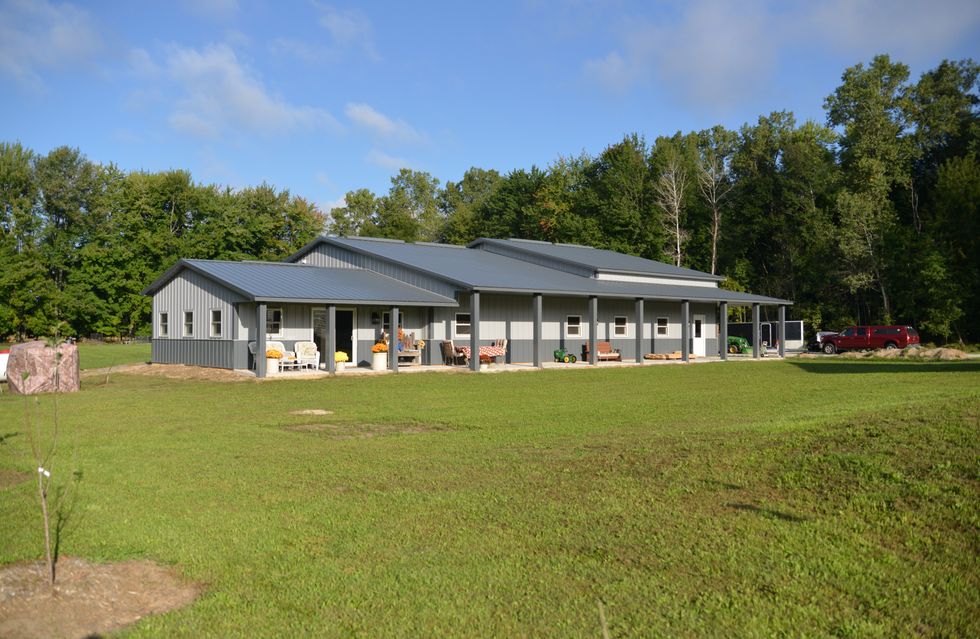
Photo: Wick Buildings
Brynn Wildenauer is part of the Sherwin-Williams DesignHouse, a team of color experts who focus on future color trends. According to her, the color research that she and her colleagues conduct “never really stops.”
Every few years, the company develops a comprehensive color forecast report that distills data and insights from various sources, including paint color sales and order volumes, color sample requests, and broader research on cultural trends impacting paint color decisions.
The following information highlights what Wildenauer sees as an overall trend in both warmer colors and in colors that complement nature. Let’s take a closer look.
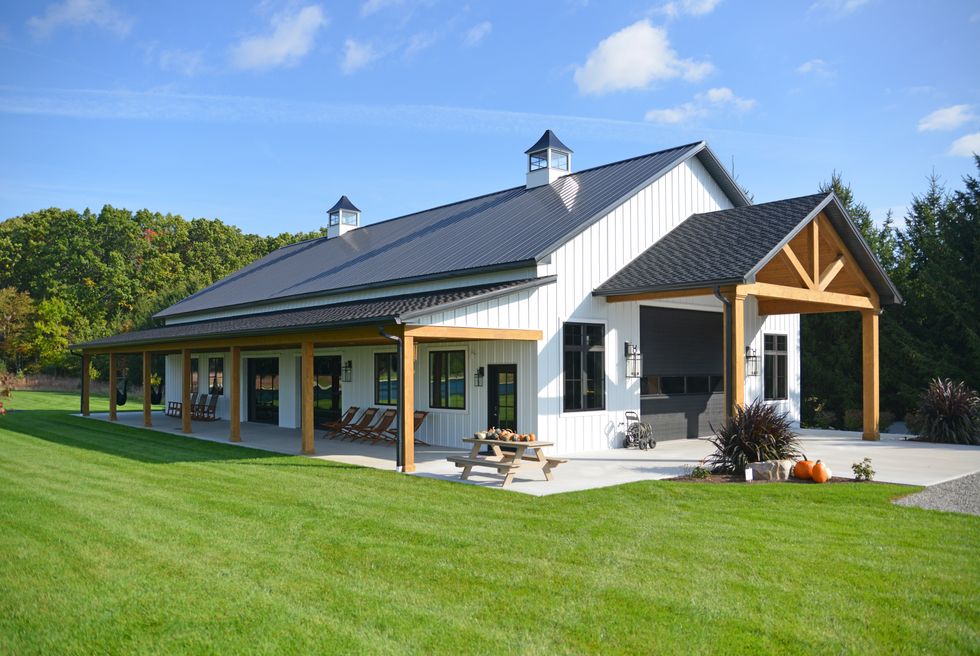
High contrast colors—for example, think of pure white exterior walls with a black roof—have been quite popular in recent years. But according to the DesignHouse team, that trend is definitely evolving in a new direction.
“We're seeing lower contrast, even monochromatic, color schemes growing in popularity,” she says. “And across the board in all industries, we’re seeing neutral colors warming up.”
That means warmer grays and whites are growing in popularity as well as warmer mid-tones in greens and blues.
And this trend is even reflected in the darker shades, says Wildenauer, with stark black giving way to warmer charcoal shades, evidenced, for example, by the popularity of charcoal gray here at Wick Buildings. Moreover, pairing, for instance, charcoal tones with warmer gray accents also fits with the growing preference for monochromatic color schemes.

Research from the Sherwin-Williams DesignHouse also shows a retreat from orange-toned colors and a resurgence in tans and beiges, as well as browns and bronzes.
More specifically, Wildenauer says people are opting for colors that “mimic nature” and complement the natural space surrounding their building.
That’s an especially important point when it comes to pole barns, which are often built within agricultural environments and on rural properties.
But the growing trend in more natural colors doesn’t mean a big drop in chromatic color choices like red or green. On the contrary, Wildenauer says, “Chromatic colors will likely stay popular. In fact, they actually allow people to complement or subtly contrast with the natural environment in some really intriguing ways.”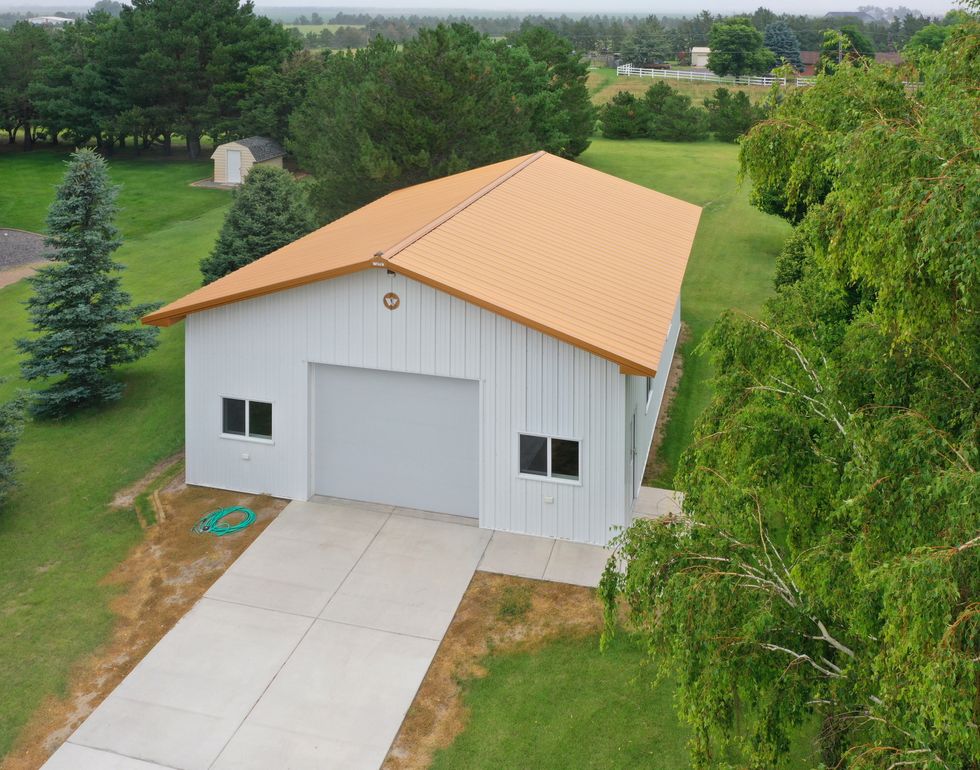
Understanding the options and trends described above is a helpful place to begin contemplating potential colors. But just remember that it's you who will be looking at your building for many years to come. Ultimately, you need to be happy with the colors you choose.
Brynn suggests answering questions like the following to help you make smart choices:
Also, keep these related tips in mind:
Match to other buildings. Most people try to match, or at least coordinate, their garage or shop colors with nearby buildings.
Think about the natural landscape. Even if nearby buildings aren't a concern, you still have the surrounding natural landscape. Try to visualize how your building’s colors will fit with it throughout the year.
Check on potential color restrictions. Depending on where you live, you may want to confirm there are no zoning laws or restrictive covenants for color choices.
Don’t forget about the power of accent colors. Sure, your roof and walls will likely comprise around 95% of the external steel on your garage or shop pole barn. Just remember that features like your trim, doors, soffits, and wainscotting can be contrasted or coordinated with your primary color choice to create a combo you’ll love.
Realize not all paints are equal. Wick Buildings uses Sherwin-Williams’ WeatherXL silicone-modified polyester coating. Designed for maximum durability, this cutting-edge formula maintains extreme resistance to abrasion, chipping, and marring and has tremendous color and gloss retention. It also has a 40-year warranty against peeling, cracking, flaking, and blistering, and a 30-year warranty against chalking.
As you ponder your color options, keep in mind that Wick Buildings offers a new 38-color palette from Sherwin-Williams. That means customers get both premium Wick steel with G-90 galvanization for better corrosion protection AND cutting-edge Sherwin-Williams WeatherXL™ coating for maximum durability.
Ultimately, it’s our customers that will benefit. “Wick customers have a unique offering of colors to choose from that can inspire a new, forward-thinking color scheme,” says Brynn.
We want our customers to have options—a lot of them. That’s why we’re offering such a wide spectrum of color choices. The following shows examples of our base colors.
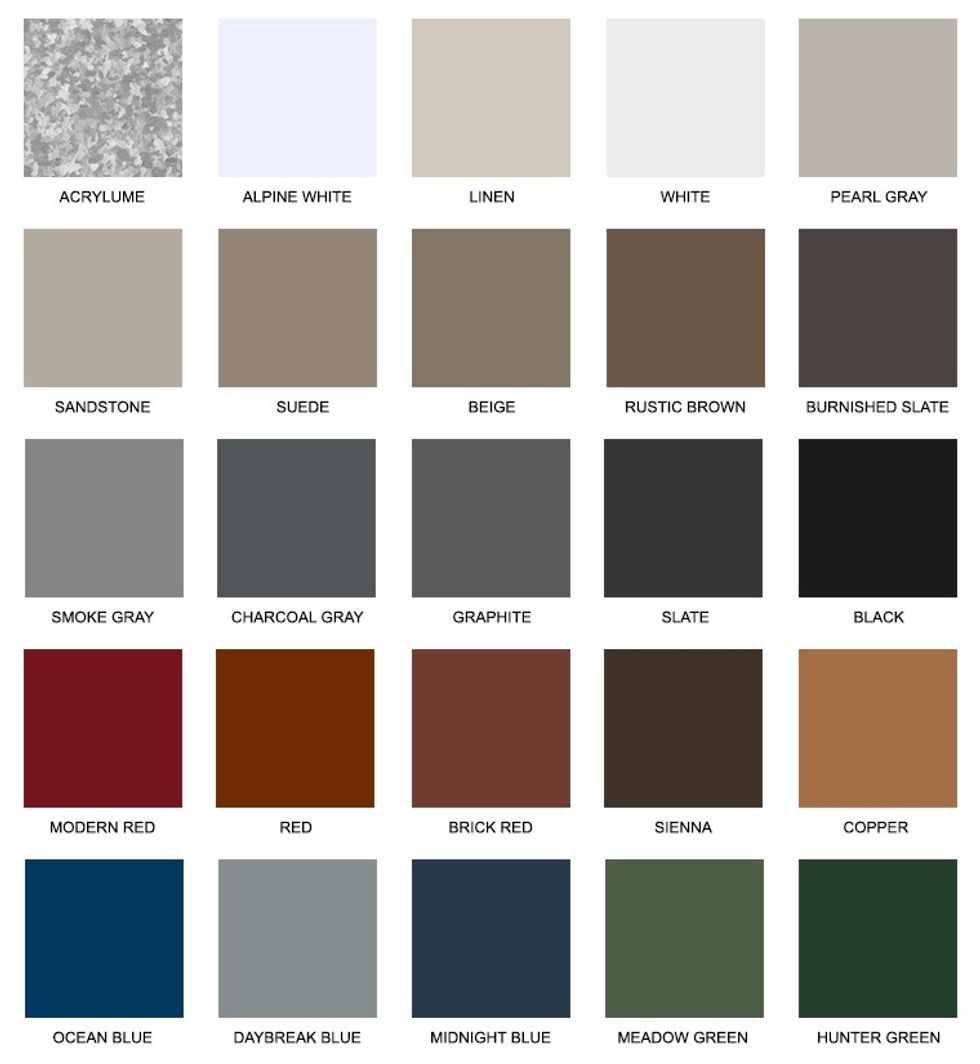
Photo: Wick Buildings
Keep scrolling down to see additional color options with special features.
Wick Buildings also offers seven “crinkle” texture finishes. The texture feature is made possible through a special chemical process that occurs in the coating’s baking process.
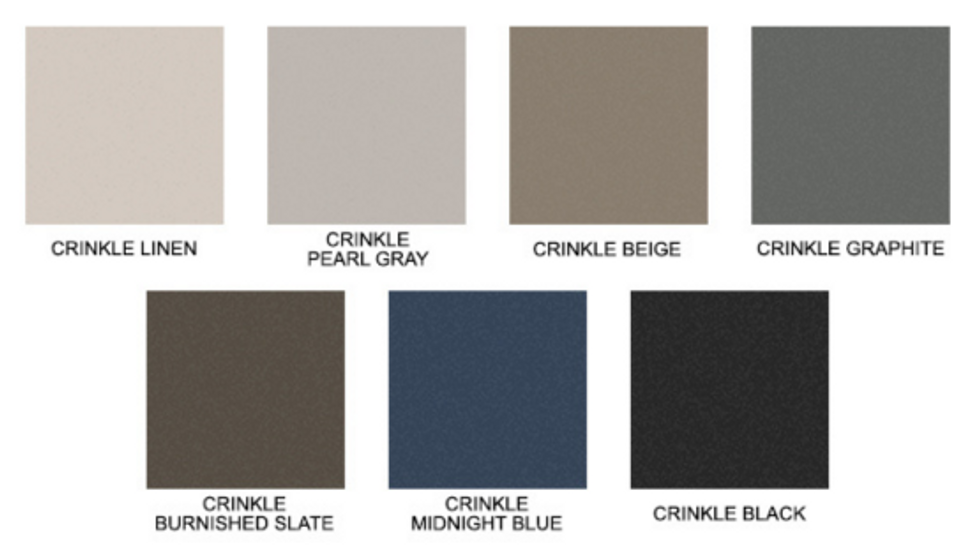
Photo: Wick Buildings
“The texture is both tactile and visual, giving a dynamic effect to the color,” explains Brynn. “These options really give customers the ability to create subtle but interesting contrast.”
Through a process known as rotogravure printing, our new print options simulate four different wood grains and two versions of weathered metal.
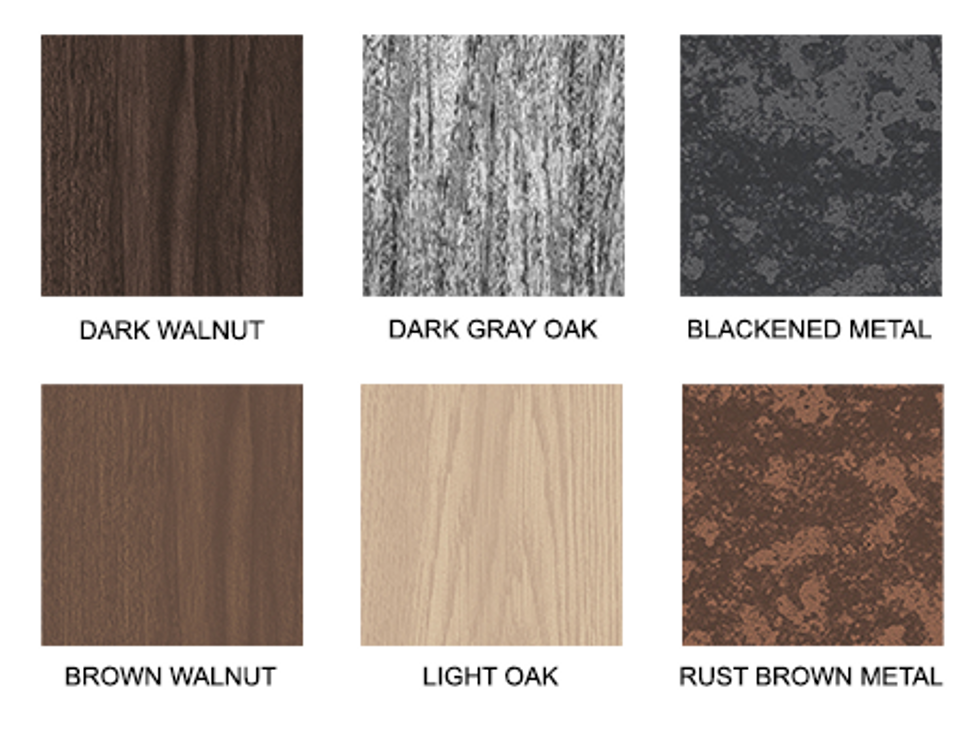
“These new print options are just one more way that Wick customers can create a unique look for their pole barn,” says Brynn.
Now that you’ve read about color options, the perfect next move is to begin experimenting.
To help you do that, make sure you check out Wick’s free Design 3D™ tool. You’ll be able to see your color choices come to life right before your eyes in exciting 3D renderings!
And don’t forget that you can also contact your local Wick Builder.
The New Owner Of This 1957 Chevrolet 3600 NAPCO Conversion Found The Perfection They Were After
As the owner and operator of Elite Classics, a Leesville, South Carolina-based collectible vehicle dealership, Russell Smith has seen his fair share of head-turning hardware. Smith tells us that his interest in all things automotive led him to establish a business that specialized in the service and resale of Corvettes back in the 80s, which in turn led to a wider appreciation for General Motors performance.
“The GM muscle cars, in particular – I just love them,” Smith says. “And through this network of buying and selling these cars over the years, in the late 90s I met this gentleman who now owns Eagles Mere Auto Museum in Laporte, Pennsylvania. And I started buying lots of cars for him.”

Smith says that the museum is essentially a passion project for the founder. Open to the public during summer months, the facility boasts more than 600 vehicles, along with a treasure trove of automotive memorabilia.
“There’re a few Fords in there, but like me, the owner is a GM guy,” he explains. “The collection is a little out of control, to be honest. There’s a bit of everything – COPOs, Yenkos, gassers, and nearly 70 different ’57 Chevys, including a Black Widow. And of course, a huge collection of Corvettes.”
Smith notes that the museum’s owner has a keen interest in vintage Chevrolet pickups as well.
“He absolutely loves anything that’s NAPCO related. He’s always on the hunt for them.”

The Northwestern Auto Parts Company, or NAPCO, was a Minneapolis, Minnesota-based parts manufacturer that specialized in four-wheel system components and accessories. Since GM didn’t have their own in-house four-wheel drive system until 1960, the automaker partnered with NAPCO to offer a four-wheel drive conversion on various GM truck models throughout the 1940s and 50s. Dubbed the Powr-Pak kit, these conversions were eventually offered as a factory-installed option in 1957. Only about 500 truck buyers ended up springing for the upgrade that year, though, making this ’57 3600 pickup an especially rare machine.
“Someone had sent him the Hemmings ad for the truck,” Smith recalls. “And he immediately called me up and just said, ‘Buy this for me.’”
Even a brief glance at the comprehensive listing makes it obvious why Smith’s friend was so interested in this specific truck.

“He loves that turquoise color, and it’s got that NAPCO 4x4 conversion. It’s also a ’57, a model year he’s really crazy about. And the representation of the vehicle in the listing really made an impression. The write-up was comprehensive, and there were a ton of good pictures, so that provided a lot of important information and a look at every bit of the truck. I felt confident buying it without being able to see it in person beforehand, which is not something I normally do.”
The fact that this original Southern truck had recently been treated to a full nut-and-bolt rotisserie restoration – rebuilt to its original specifications with matching vinyl interior – didn’t hurt either. Motivation comes from Chevrolet’s 235-cu.in. OHV inline-six-cylinder engine, good for 140 horsepower and 210 pound-feet of torque, which is paired up with a four-speed manual transmission.

“Since we were serious about buying, the first priority was finding out where the reserve was, and hopefully we’d be able to flush out the tire kickers in the process,” Smith says. “We had a number in mind for what we were comfortable paying for it, but with these things you never really know. So we started bidding to see where it would go. And if it went over the number we expected without hitting the reserve, then we’d reevaluate it.”
11 bids later, they hit the reserve. “Fortunately for us, no one bid against us at that point,” he says with a laugh. “From my experience bidding on other auctions over the years, if someone continues to bid up to the reserve like we did and then another party then gets involved in the bidding, you’re in for a battle.”

Shortly after the auction closed, Smith wired the money to the seller, who in turn sent the truck’s documentation to him via Fedex.
“The seller was really easy to work with, a really nice guy. We’ve become friends in the time since, and I think we’re going to buy more vehicles from him in the future. And that’s entirely thanks to this auction.”
After being transported to Pennsylvania, the truck was given a thorough once-over by the team that maintains the museum’s vast collection of vehicles.
“We have a checklist that we go through prior to driving anything that we buy,” says Smith. “All of the vehicles in the collection run and drive. So the first thing we did was flush and replace all of the fluids, even though everything looked good when it arrived. That way we know exactly where we stand with all of the maintenance, and that it’s safe to drive. We found zero issues with it, so we’re extremely happy with how it all played out.”
Smith notes that, although they look sharp on the truck, they plan to swap out the pickup’s wheels and BFGoodrich all-terrain rubber for period-correct factory wheel and tire setup to bring it in line with the historically-accurate theme of the rest of the truck. But other than that, it’s destined to live a pampered life in the museum’s collection, where it’ll be admired by a myriad of enthusiasts over the coming years.
“It was so clean when it arrived, there really wasn’t much that needed to be done. The team that does our vehicle inspections does a really thorough job, and they were happy with it. When they say it’s good, I know it’s good.”